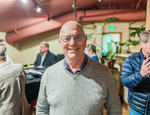


The first time he was asked to help out, he said, “No, thank you.”
But over a decade later, Jim Kramer made his departure from the Chehalis Basin Strategy earlier this month. And without him, the strategy — a collaboration of local leaders who pursue flood mitigation and aquatic species restoration for the basin — might not even exist.
When the Chehalis River flooded in 2007 and 2009, water, mud and debris destroyed property, killed beloved pets and uprooted infrastructure worth millions.
After the water receded, the gritty, rural basin was poised for action. Survivors saw their community rush to their aid. Houses were cleaned and rebuilt and shoulders were offered up for crying. Local leaders banded together to advocate for mitigation in a group that became the Chehalis Basin Flood Authority.
But, not three years later, infighting — largely between proponents and opponents of building a dam one mile upriver from Pe Ell — brought the process to a standstill. Kramer, of Seattle, combined with the focus of Gov. Christine Gregoire, became unlikely but key players in moving the process forward.
A facilitator who worked on several salmon-related projects in Washington, Kramer got a call from the Ruckelshaus Center, an organization of consultants and volunteers who specialize in problem-solving, especially for environmental public policy issues.
The call came at the behest of Gregoire’s office in 2011 and requested Kramer do a situation assessment on the Chehalis Basin.
“I read the news reports and did a little bit of research, called back, and said, ‘No, thank you,’” Kramer said, laughing, during an interview with The Chronicle this month. “The director said, ‘The governor asked if you would do this and there was one answer. And you haven’t given the right answer.’”
He agreed, then, to a three-month assessment. In the weeks following, Kramer interviewed over 60 people from the basin on their experience in the flood and the years following. He spoke with farmers, Chehalis Tribal Council members, and local government officials and staff.
Dave Fenn, a farmer on the South Fork Chehalis River in Boistfort whose land flooded in 2007, recalled the first meeting he had with Kramer.
“Not much headway was being made and you kind of wonder what’s another person going to help?” Fenn said this week.
But Kramer said he was able to earn the basin’s trust by listening. He took photographs and compiled a report of unedited transcripts, letters and emails containing bittersweet testimonies of loss and teamwork. These people, he said, needed to be seen.
“Many of the people involved did not like each other and actually did not like working together,” Kramer said flatly. “But what they feared the most is that they were going to be yet another group of leaders that failed their community.”
And because their priorities aligned, he said, with the right process, community members could work together. He recommended the governor create the Chehalis Basin Work Group, which would, years later, become the Chehalis Basin Board, overseeing the Department of Ecology’s Office of Chehalis Basin.
As it stands today, two members are appointed by the governor, three from the Chehalis River Basin Flood Authority, one member and an alternate from the Confederated Tribes of the Chehalis Reservation, and one from the Quinault Indian Nation. Kramer became the facilitator.
Even when he was no longer being contracted by the Ruckelshaus Center, he remained involved.
“Those kinds of stories, I mean, there’s no way you can’t be moved by that,” Kramer said of his assessment project. “This is the core of what humanity is. People, not only their experience with tragedy, but their experience with people coming out of the woodwork to help them. … That’s why I do this work: to connect to that humanity that’s not on display in our culture.”
Fish
After working on salmon habitat restoration elsewhere, Kramer realized early on that the Chehalis River Basin was lacking the science necessary to restore the basin’s dramatically-reduced salmon populations.
“I was excited because we had this opportunity to create a plan for the species in the basin. Basically, we could start from scratch,” he said.
But, when he presented the idea of a restoration plan to various agencies, “they showed almost zero interest in it. … They were more focused on, ‘Well, they’re proposing a dam down there, and we care about fish.’”
It took a top-notch fish scientist formerly of the Department of Fish and Wildlife, Mara Zimmerman, to apply climate change models and fill the scientific gap, Kramer said. That localized climate prediction, he said, had never been done on that level in the state. Through this work, all while working with proponents of a dam, Kramer was able to bridge partisan gaps related to climate change and ensure that both flood mitigation and habitat restoration be funded equally by the state going forward.
“When I got involved it was all about the flooding,” he said. “It’s just clear to me that you can’t address flooding issues without having an environmental effect. (Pursuing both goals was) the only way that I saw that you could meet this basinwide desire to have benefits for all.”
Else’s Rule
Even when both fish and flood issues were both recognized as important, animosity between the work group members was apparent. While he worked as a meeting chair and agenda-setter, much of Kramer’s work was done one-on-one outside of meetings.
Fenn, whose family has resided along the South Fork for 110 years farming “most anything you can think of,” said this was Kramer’s specialty.
“The interesting thing about him is you really don’t know what he’s thinking. He doesn’t give you good or bad vibes usually,” Fenn told The Chronicle, later adding, “Having the support and the engagement of the agricultural community was very important. … (Kramer made) sure they were recognized in this whole process and I deeply appreciated that.”
One of his techniques early on to help the work group learn to speak with respect for one another, he said, was named for his step-daughter, Else.
Now 18, Else was in third grade at the time and learning a communication technique called “THINK.” Before you speak, her teachers said, THINK: is what you’re about to say true, helpful, important, necessary and kind?
“If you said something that the other person was offended by, that person who was offended had to say, ‘Ouch.’ It became Else’s rule.” Kramer said, laughing. “Even though they hadn’t met Else, they were endeared to her.”
As the process was stalled by the dam versus anti-dam argument, Kramer worked to have the leaders step back from their positions and focus on their interests.
“When you're arguing about your positions on something, you just keep going like, ‘Well, if I just brought more facts, you would understand and agree with me.’ And then you get into this, ‘My facts are better than your facts,’ you know? And it just does not ever win,” Kramer said.
A Good Coach
It would be easy to believe, Kramer said, that because the dam has not been officially approved or scrapped, the Chehalis Basin Strategy has not worked. But, looking closer, both as the work group and in its current form, the board has secured millions of state dollars for scientific understanding, several flood mitigation projects and habitat restoration.
The strategy’s website states it has completed 100+ projects, with dozens more underway.
“I simply cannot tell (Kramer) ‘Thank you’ enough for helping our basin develop a plan to move forward on to reduce flood damages and move collectively and cohesively on restoring our salmon runs,” said Jay Gordon, a Chehalis Basin Board member, who called his colleagues’ skills “invaluable and rare.”
Now, with the proposed dam undergoing the final environmental review stages, Kramer said it was time for him to move on and let someone else revive the facilitator role, bringing the project to the finish line.
He hopes to find a role helping California’s water crisis in the San Joaquin Valley, where he said the challenge is “unbelievable,” and the leaders are “amazing.”
“I also think it’s really important, if not more important, is it felt like the Chehalis Basin effort needed some infusion of good support. The next two years, the hope is that they come to a conclusion,” Kramer said, later adding, “The coach metaphor is a good one. And good coaches and highly successful teams have planned their transition in advance and been developing people along the way.”
At Kramer’s going away party last month, he said, his favorite part was seeing the diverse group of people he’d worked with sharing laughter — and interests.
•••
Isabel Vander Stoep, the author of this story, is the daughter of J. Vander Stoep, who was one of the original members of the Chehalis Basin Governor’s Work Group and now serves on the Office of Chehalis Basin. The Chronicle assigns coverage of the office’s meetings to another reporter to avoid conflicts.